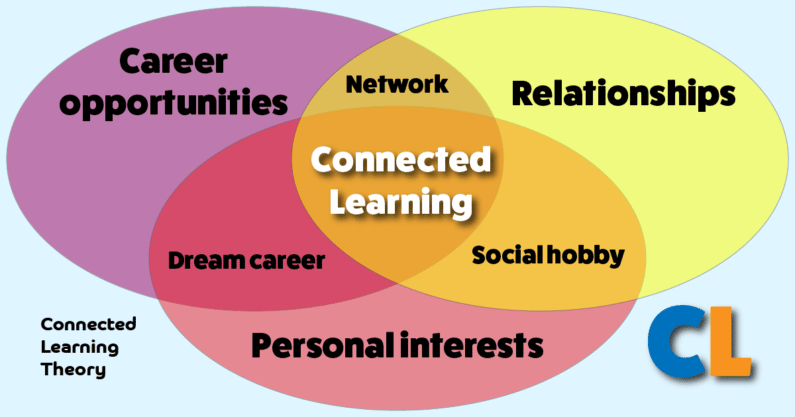Connected learning is a different type of learning from what most people are familiar with. The learner pursues a personal interest in an active, engaged way that involves others. The idea is to make learning what it should ideally be: engrossing, joyful and impactful.
Definition of Connected Learning
Connected learning is a learning process where (a) the topic is of special personal interest to the learner (b) instructors, mentor, peers and/or friends are actively involved and (c) outcomes extend beyond academic achievement.
An Explanation of the Theory
Making learning meaningful to the young people being taught is a refreshing way to look at learning. Connected learning is also a potential path to innovation. The theory forces instructors to consider alternative ways to make learning engaging and effective.
The idea of starting a learning journey with a subject of personal interest stems from an attempt to make learning more enjoyable and meaningful. The teaching model rests on the foundations that young people are more invested in learning when:
- the topic interests the learner
- they receive direction from peers or mentors who have the same interest and
- there is a solid outcome at the end in terms of personal advancement.
Basketball Example

I can’t help thinking of my son’s rapid improvement in basketball as an example where connected learning principles are at work.
- The topic was clearly of interest; he played and practiced whenever he could and also watched game footage and tutorials on YouTube.
- The social experience was most intense on the middle-school basketball courts during breaks. Classmates of differing ages and abilities came together to play, show off moves and talk about the game. My son was particularly close to a boy who played at a high level in an older age group. The older boy acted as a mentor. I also coach my son when I get a chance as I used to play as well and also have an interest in the game.
- The level of personal advancement could be seen in games for both a club and the school. Gains could be seen in scoring but also in unrecorded stats, such as shot blocks, and when he successfully performed new moves.
The basketball example possibly doesn’t count as connected learning because it’s not tied to academics in an obvious way and, realistically, the career opportunities are limited. But the example shows the power of the connected learning theory.
Through basketball, my son has clearly discovered his own learning potential. Importantly, he has learned how to learn. Anything he sets his mind to in the future, including in education, can benefit from the insights gained into how to achieve goals and be successful.
Connected Learning Design Principles
There are several principles which must be met in order for connected learning to be successful. These principles include a learner-centric process, the meeting or exceeding of national academic standards, the addressing and elimination of ethnic academic achievement gaps, and guaranteed active learning. There are several more integral principles, all of which aim to make connected learning a rewarding process that will encourage the learner to advance their opportunities.
So, if you are a young person struggling to engage completely in learning and would like to try out an alternative model of teaching then you should definitely look into connected learning. Of course, connected learning is not a substitute for school education. But it is a great alternative way to meet new people, share your interests and find a way of learning that suits you best. It should be noted that connected learning is still very much developing, but there is a future for it in aiding the education of young people.
Benefits for Learners
The main benefit of connected learning (which is also its main goal) is for young people to get truly invested in learning and make a success out of it. Connected learning provides them with a precise framework to do that because it guarantees academic or career success or advancement at the end. The more young people who become invested in learning, the more success stories there will be, and all of those successes will demonstrate how effective the connected learning model is.
Another huge benefit of this type of learning for those involved is the chance to branch out and form new relationships. Often, new relationships are not formed at school because children already have a solid group of friends and are taught every week by the same teachers. And while those relationships are incredibly important, the teachers have a lot of very different students to focus on and friends do not necessarily share the same interests.
Connected learning means that young people can come to associate learning with their personal interests and have relationships with people who enjoy the exact same things. Young people need plenty of variety in their lives as well as people to listen to them, so connected learning really does live up to its name in that sense.
Leading on from the above point, connected learning is also a great alternative from the school teaching system. While every young person needs to go to school, their needs may not be completely met, especially with such packed classes and sometimes limited resources. Connected learning is not intended to replace school teaching, but it is supposed to be another way to teach young people and engage with them on a personal level that schools simply cannot.
Connected learning focuses on production and purpose and allows those things to occur based on personal interest and peer relationships. Putting those things first benefits the learners’ social skills, gets them to take pride in their interests, and, best of all, gives them a way to learn that they will look forward to.

